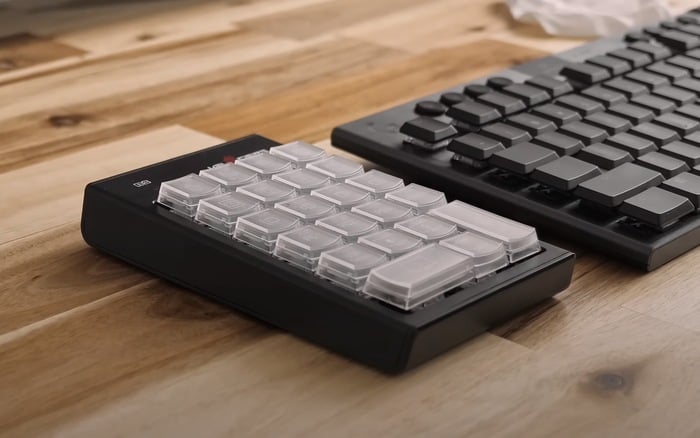If you find you have lots of different remote controls to perhaps turn on or adjust your lighting, desk, PC or other tech gadgetry on your desktop. It might be time to build a custom programmable keypad to control all your gadgets from a single remote. This approach consolidates multiple controllers into a single, programmable device, enhancing efficiency and making it much easier for you to access everything and program each button as required.
The idea of programming a single remote to control all devices is a game-changer. Imagine having a single controller that can switch HDMI and USB inputs, control desk height, manage lights, toggle the microphone, manage windows, and even launch the web browser and file explorer. This not only simplifies the user experience but also enhances productivity by reducing the time spent on managing different controllers.
The problem with multiple separate controllers for a desk setup is that they can be inconvenient to use individually. Each device, from the monitor to the standing desk, the lights to the microphone, has its own controller. This not only clutters the workspace but also interrupts workflow as one has to reach for different controllers for different functions.
Build a custom programable keypad to control your tech
The addition of macros to the keypad for window management is another significant feature. Macros allow for quick window resizing and launching of most-used applications, further enhancing efficiency.
Previous articles we have written that you might be interested in on the subject Raspberry Pi mini PC :
Wireless or wired
Possible requirements for the single controller are that it should be wireless, have a long battery life, be quick and responsive, and be simple and intuitive to use. To meet these requirements, an RF wireless number pad from Velocifire was used in the example in the video although you could use any other to suit your needs. You could also make it wired if preferred connecting it to your PC for power using a USB cable.
The USB dongle for the keypad was plugged into a Raspberry Pi Pico flashed with an HID remapper firmware. The Raspberry Pi Pico mini PC sends commands to the desktop PC, which are received by an AutoHotkey script. This setup ensures quick and responsive button presses, fulfilling one of the key requirements of the controller. For controlling lights and the TV screen, the system sends a post request to a home assistant server. This integration of smart devices with the Home Assistant server further simplifies the control process.
Non-smart devices were made smart with a USB power switch and a USB switch. This innovative approach ensures that all devices, smart or not, can be controlled from the single controller. One of the challenges faced was the reverse engineering of the standing desk controller for integration with the Home Assistant. However, overcoming this challenge was crucial to ensure that the standing desk could be controlled from the single controller.
Benefits of a programmable custom keypad
- Customization: You can tailor the keypad layout, key functions, and even the form factor to your specific needs. Whether you’re optimizing for gaming, coding, or specific workflows, customization can lead to increased productivity.
- Cost-Efficiency: While commercial keypads can be expensive, using a Raspberry Pi Pico is relatively inexpensive. This allows you to achieve high functionality at a lower cost.
- Learning Experience: Building the keypad yourself offers hands-on experience with hardware, firmware, and potentially software development. This can be valuable both for educational purposes and for enhancing technical skills.
- Wireless Flexibility: Implementing wireless functionality makes the device portable and easier to integrate into various setups. You’re not constrained by cables, and you can use the device more freely.
- Expandability: Once your base platform is built, you can easily update the firmware to add more features or adapt to changing needs. You’re not stuck with a static product; you can modify it over time.
- Open Source: Using open-source software and hardware for your keypad allows you to benefit from community support and to contribute back to that community with your own improvements or adaptations.
- Energy Efficiency: The Raspberry Pi Pico is known for its low power consumption, which is especially beneficial for wireless devices that are battery-powered.
- Speed and Responsiveness: The device’s performance can be optimized since you control the firmware. This could be crucial for applications requiring low latency, such as gaming or real-time control systems.
Creating a wireless macro pad to control a computer desk setup is an innovative solution to the problem of multiple separate controllers. It simplifies the user experience, enhances productivity, and paves the way for a more efficient and intuitive workspace. Despite some limitations, the potential for future improvements makes this an exciting development in the realm of technology.
Filed Under: DIY Projects, Top News
Latest aboutworldnews Deals
Disclosure: Some of our articles include affiliate links. If you buy something through one of these links, aboutworldnews may earn an affiliate commission. Learn about our Disclosure Policy.







